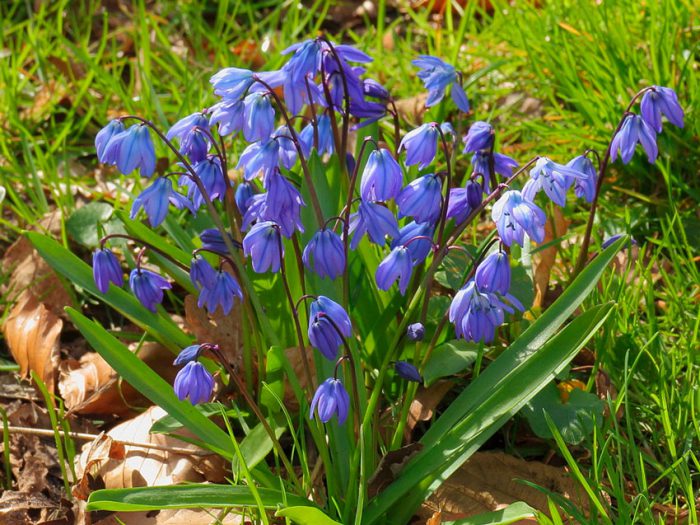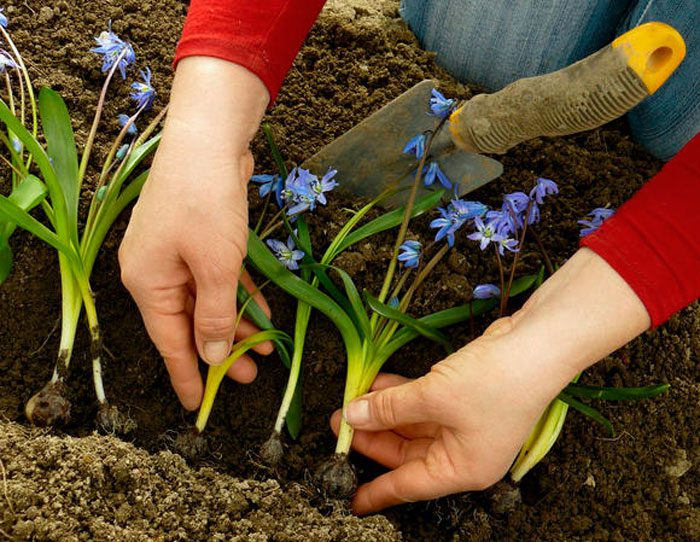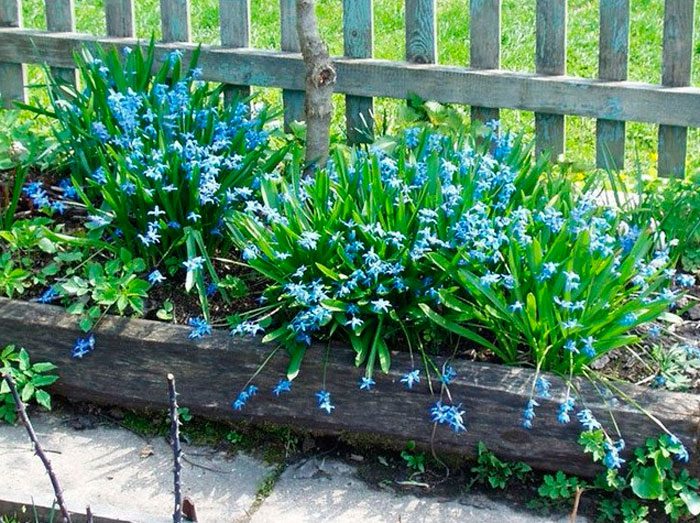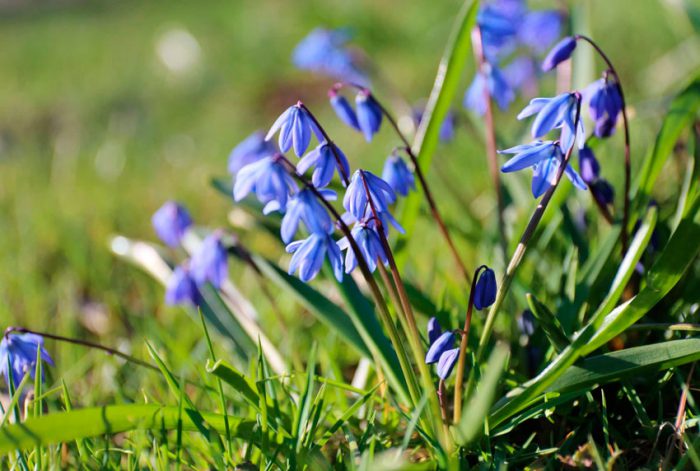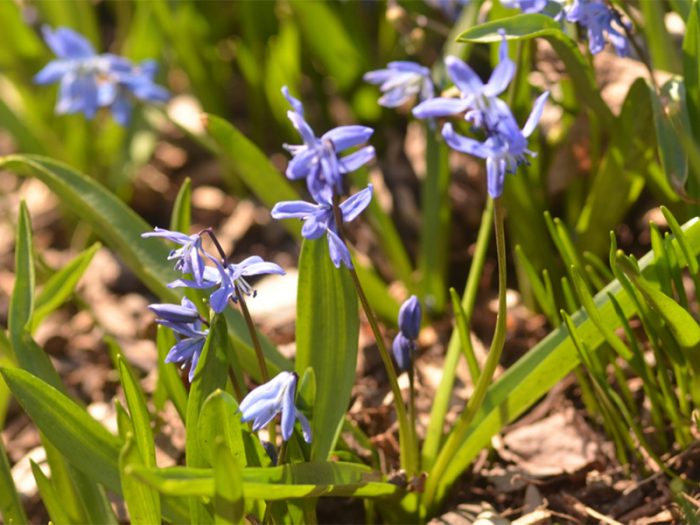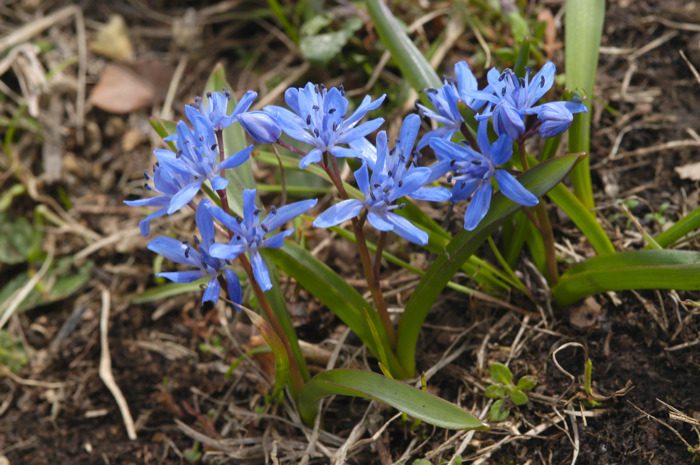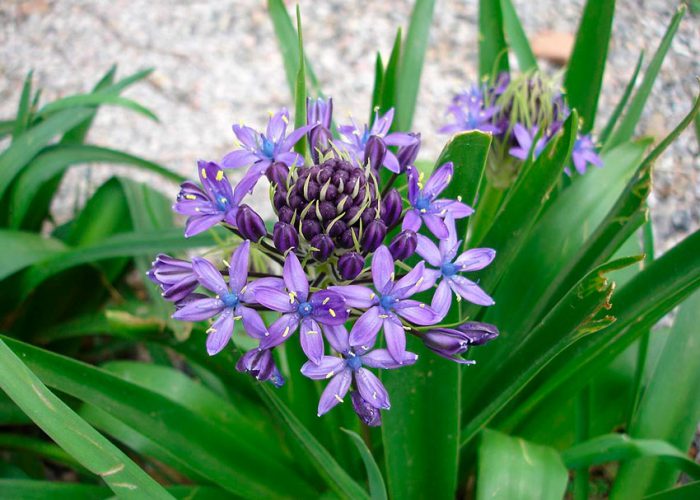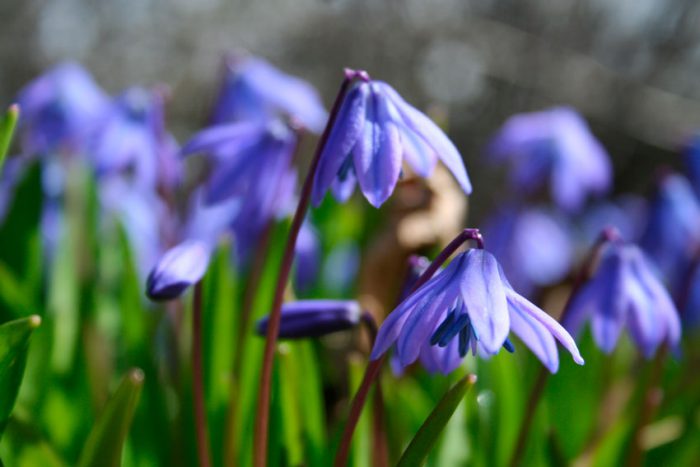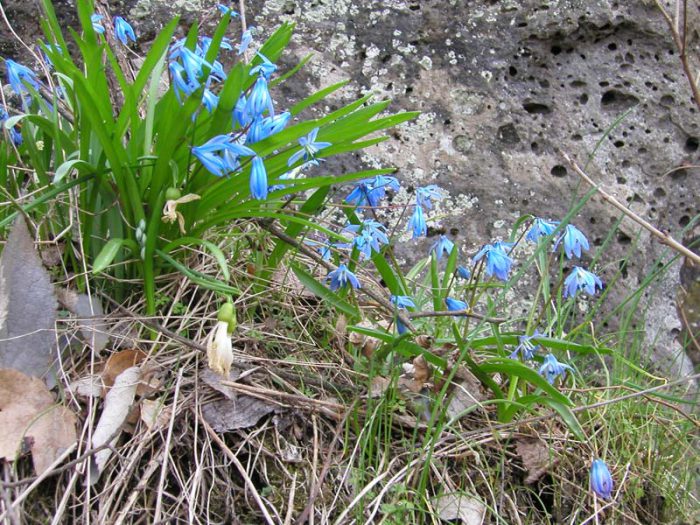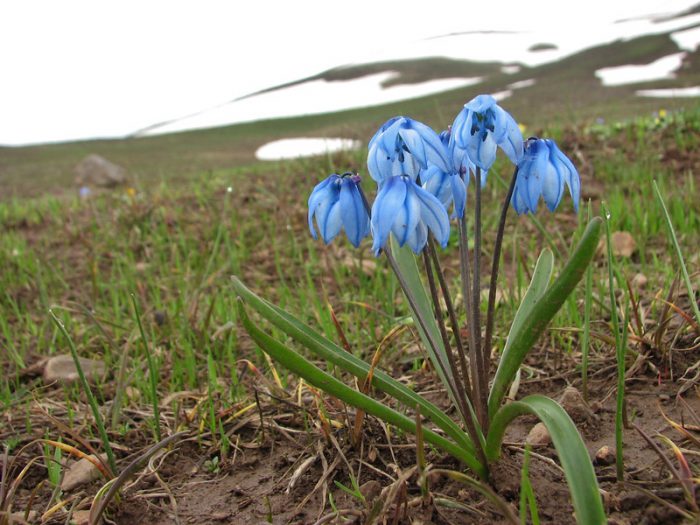A bulbous perennial such as scilla is a member of the asparagus family. However, some time ago this flower was attributed to the lily or hyacinth family. This plant is also called scilla. Often such a flower is mistaken for a snowdrop or forested plant. This genus includes about 90 different plant species. In natural conditions, they can be found in Africa, Asia and Europe, while they prefer to grow in plains and mountain meadows. The name of such a flower comes from the Greek name of the sea onion "skilla", the fact is that it was previously a representative of this genus. Such a plant is highly resistant to frost and disease, and it is also very beautiful and able to quickly adapt to any environmental conditions.
Content
- 1 Features of the woodland
- 2 Planting a scilla in open ground
- 3 Scylla care in the garden
- 4 Scylla after flowering
- 5 Types and varieties of scilla (proleski) with photos and names
- 5.1 Scilla hispanica, or Spanish endymion (Endymion hispanicus), or campanulate scilla
- 5.2 Double-leaved scilla (Scilla bifolia), or double-leaved scilla
- 5.3 Autumn scilla (Scilla autumnalis), or autumn scilla
- 5.4 Peruvian Scilla (Scilla peruviana), or Peruvian scilla
- 5.5 Siberian Scilla (Scilla sibirica), or Siberian Scylla
Features of the woodland
A bulbous plant such as scrub is a perennial. The bulbs are round or ovoid, and their outer scales are purple, dark gray or brown. Basal linear leaf plates grow earlier or at the same time with the apical inflorescences, which have the shape of a brush and are located on leafless peduncles. Such a plant has one feature, for example, its leaves on rainy, cool days are pressed against the surface of the soil, while it is warm and sunny outside, they are located almost vertically. The inflorescences include single flowers. The fruit is a box, inside of which there are irregular ovoid seeds of black color. Proleska is a primrose, like the following plants: brandu, white flower, dream-grass (lumbago), goose onion, daffodil, pushkinia, chionodoxa, hazel grouse, saffron (crocus), adonis (adonis), erantus (spring), hyacinth, muscari, snowdrop, primrose, dwarf iris and buttercup. The flowering of most species of Scylla is observed at the beginning of the spring period, but there are also such species that bloom in the autumn.
Planting a scilla in open ground
What time to plant
Planting and growing woodland is fairly simple.These flowers are used, as a rule, to decorate borders, rockeries, alpine slides and mixborders. Also, the trunks of garden trees, which adorn the beautiful flowers of scilla in early spring, look incredibly impressive. Such a plant can be planted even during the flowering period. However, experts recommend planting spring-flowering Scylla after the leaf plates die off (from mid-June), and those that bloom in spring - 4 weeks before the formation of peduncles. These flowers prefer well-lit areas, but they can also be grown in shaded areas. It should be borne in mind that autumn-flowering species are not so light-loving compared to those that bloom in spring.
Landing features
Before proceeding with the direct landing of the scilla, it is necessary to prepare the site. Best of all, such a plant will grow in soil with a large amount of organic matter, which includes mineral components and leaf humus. In order for these flowers to grow and develop excellently, it is recommended to mix garden soil with forest soil, which contains semi-decomposed tree bark and foliage. A suitable soil acidity should be between 6.5 and 7.0.
A distance of 5 to 10 centimeters must be kept between the landing holes. It is necessary to deepen the bulbs into the soil by 6-8 centimeters (depending on the size of the planting material).
Scylla care in the garden
Proleska is distinguished by its extreme unpretentiousness when compared with other spring flowers. In order for this flower to grow normally, it must be watered, if necessary, and after that it is imperative to loosen the soil surface to a depth of 20–25 mm, while weeding. Watering is recommended in the morning, while you need to try so that the liquid does not fall on the surface of the flowers, as this can greatly spoil their appearance. In order to significantly reduce the number of weeding and watering, the area where the scilla grows should be covered with a layer of mulch (deciduous humus).
Spring flowering woodlands need to be fed with a complex fertilizer (for example, Nitrofoskaya) at the beginning of the spring period, due to which the flowering will be much more magnificent. And it is recommended to arrange feeding for autumn-flowering species in autumn. It is best to add trace elements such as iron, magnesium, calcium and copper to a complex mineral fertilizer.
It should be remembered that these plants reproduce well by self-sowing. If you do not have the desire to regularly remove unnecessary scilla from the site, then it is necessary to cut off the fading flowers, trying to do this before the testes appear.
Transfer
For the normal growth and development of this plant, it must be systematically transplanted 1 time in 3 years, this will also allow the bushes to be highly decorative. Having dug a bush, it is necessary to separate the children from the bulb, after which they are seated as soon as possible in order to avoid the appearance of rot on the bulbs. Experts advise to transplant in the last days of September or the first in October.
Reproduction of scilla
Seeds and daughter bulbs are used for reproduction. How to propagate with bulbs is described in detail above. In order to grow such a flower from seeds, you first need to collect them. Around the last days of June, the seed pods should turn yellow and begin to crack. These boxes must be collected and seeds are poured out of them, which are immediately sown in open ground. Such seeds have a relatively low germination rate, while bushes grown from seeds will bloom only when they are 3 or 4 years old. The first planting of such plants is produced no earlier than 5 years later, during this time they will have a large number of children, and the number of peduncles will also increase.
Diseases and pests
Like all small-bulbous plants, this flower is susceptible to infection with achelenchoides, gray rot and bulb rot.The greatest danger of all pests to such a plant is the root meadow mite and murine rodents.
Gray rot appears on leaf blades and on the top of the bulb. On the affected parts of the plant, gray mold appears, and they begin to rot. Then dense spots appear on the bulbs. As the disease develops, the bushes turn yellow and die. The affected specimens should be dug up and burned as soon as possible. If the stored bulbs have become infected with gray rot, then the problem areas should be cut out and the wounds should be sprinkled with wood ash.
If the spill gets infected achelenchoides, then there is a defeat of its aboveground part, as well as the bulbs. The scales on the bulbs turn brown and rot appears. So, if you make a cross section of the bulb, you will notice ring rot. In the affected bulb, necrotic spots appear on the surface. Infected specimens show a loss of decoration and developmental lag. Infected bulbs are dug up and burned. For preventive purposes, healthy bulbs should be put in a thermos with hot (43 degrees) water, where they should stay for 30 minutes.
Bulb rot appears due to fungal infections, for example: fusarium, sclerotinia or septoria. In a recently infected bush, the leaf plates begin to turn yellow, and then the infection penetrates into the bulbs, which is why spots of a dirty red color appear on their surface. If the infected bulbs are stored, they become very hard and die. This disease begins to develop very quickly at high humidity.
Mouse rodents (for example: house mice and voles) are very fond of eating the bulbs of this plant, while in spring they can eat its sprouts. To protect the scilla, it is necessary to make a protective groove around the area where it is grown. In this groove, bait with poison should be laid, and do not forget to sprinkle it with soil a little, because birds can peck the poisoned rump, which will lead to their death.
Larvae and adults root meadow mite gnaw through the bottom of the onions, and then make their way into their middle. There, pests begin to suck out the juice from the inner scales of the bulb, because of which it begins to rot and dry out. To get rid of this harmful insect, it is necessary to spray the affected bush with an insectoacaricide (for example: Agravertin, Aktellik, Akarin, etc.). For prophylaxis, before planting the bulbs in the soil, they should be pickled with one of these agents.
Scylla after flowering
After the plant has faded, the peduncle must be removed from it, while the leaf plates are cut off only after they have completely died out. There is no need to prepare the Scylla in a special way for the coming winter, because it has a fairly high frost resistance and does not need shelter. However, if these flowers are cultivated in an open area, then to protect them from winter frosts, it is recommended to cover them with dried foliage or spruce branches.
Types and varieties of scilla (proleski) with photos and names
As already mentioned, there are quite a few species of woodland, while most of them are successfully cultivated by gardeners. In this regard, a description of only those of them that are quite popular will be presented below, and you will also find the name of the most popular varieties.
Scilla hispanica, or Spanish endymion (Endymion hispanicus), or campanulate scilla
The homeland of such a plant is Spain, southern France and Portugal. Moreover, this species prefers to grow in meadows and forests. This type is considered the most effective. The bush can reach a height of 0.2 to 0.3 meters. On single peduncles there are erect inflorescences with the shape of a brush, which consist of 5-10 bell-shaped flowers, reaching 20 mm in diameter and painted in pink, blue or white.Flowering begins in the last days of May and lasts about half a month. If the bulbs remain in the open ground for the winter, then they must be covered. Popular varieties:
- Rose Queen... The height of the peduncles is about 0.2 meters, they have pink flowers with a lilac hue, which have a very faint smell.
- Sky Blue... On very strong peduncles in a spiral, large blue flowers with a strip of blue are placed.
- La Grandes... The inflorescences include 15 white flowers.
- Rosabella... The height of the peduncles is about 0.3 meters, they have dense inflorescences consisting of pinkish-lilac fragrant flowers. In the evening, their scent becomes much stronger.
Also, gardeners are happy to grow the following varieties of this type of scilla: Excelsior, Blue Queen, Blue Giant, Blue Pearl, Dainty Maid, Queen of Pinks, Mont Everest, Miosotis, etc.
Double-leaved scilla (Scilla bifolia), or double-leaved scilla
Under natural conditions, this type of scilla can be found in the Crimea, the Ciscaucasia, the Mediterranean, as well as in the European part of Russia. It is considered the smallest and most lush. The height of the bush, as a rule, does not exceed 0.15 meters. It has 1–3 peduncles, and each of them has inflorescences consisting of pink or white flowers with a sharp, but quite pleasant aroma. Each inflorescence contains up to 15 flowers. This species has only 2 broad-linear sheet plates, the length of which is about 0.2 meters. This plant begins to bloom from mid-April, and the flowering duration is about half a month. It has been cultivated since 1568. There is a garden form bifolia var. Purpurea, which has purple flowers.
Autumn scilla (Scilla autumnalis), or autumn scilla
Under natural conditions, such a plant can be found in North Africa, the Mediterranean and Asia Minor. One bush can grow up to 5 flower arrows, the height of which varies from 0.15 to 0.2 meters. They have loose racemose inflorescences consisting of 6–20 small flowers of light lilac or purple-red color. It begins to bloom in the last days of July or the first in August. The length of linear grooved narrow leaf plates is about 0.25 m.Cultivated since 1597.
Scilla peruviana, or Peruvian scilla
The homeland of this species is the Western Mediterranean. On the bush, 2 or 3 flower arrows appear, which reach 0.35 m in height. On them are dense conical inflorescences, which consist of small (diameter less than 10 mm) flowers of a deep blue color. One inflorescence can contain up to 80 flowers. The length of the linear leaf plates is about 30 centimeters, and their width reaches one and a half centimeters. 5–8 leaves grow on one bush.
Siberian Scilla (Scilla sibirica), or Siberian Scylla
This species was named erroneously, because it cannot be found in Siberia. In natural conditions, this flower can be found in the Caucasus, in the Crimea, in the European part of Russia, in central and southern Europe. Blue flowers grow at the same time with leaf plates. The flowers contain nectar. This species has one feature, the fact is that the opening of its flowers takes place at 10 am, and the closure - at 16-17 hours, while if the weather is cloudy, then they may not open at all. There are 3 subspecies of such a spade:
Caucasian (Scilla sibirica subsp.caucasica)
It can be found in nature in the Eastern Transcaucasia. The height of the flower arrows can vary from 0.2 to 0.4 m. The color of the flowers is dark blue with a purple tint. Flowering begins in the second half of the spring and lasts 15–20 days.
Armenian (Scilla sibirica subsp.armena)
In the wild, it is found in northeastern Turkey and southern Transcaucasia. The leaf plates are sickle-curved. The height of the flower arrows is from 10 to 15 centimeters, they have flowers of a deep blue color.Flowering begins in mid-spring and lasts 15 to 20 days.
Siberian (Scilla sibirica subsp. Sibirica)
Under natural conditions, it can be found in the European part of Russia, in the Crimea, in the Caucasus and in Asia Minor and Western Asia. This subspecies in culture is considered the most popular. The bushes have 3 or 4 broad-linear leaf plates, which reach 15 mm in width. The height of the peduncles is about 0.3 m, while on one bush there can be 1–4 of them. The color of the flowers is azure. Flowering begins in mid-spring and lasts approximately 20 days. In culture, this subspecies has been since the beginning of the 17th century. This subspecies has a form with white flowers, it has been cultivated since 1798, its flowering begins 7-10 days later than plants of other colors, but its duration is 1 month. There are also varieties with blue or pink flowers. The most popular varieties of this subspecies:
- Spring Beauty, at this moment this variety is considered the best, on its strong green-purple peduncles there are 5 or 6 dark purple flowers each, the diameter of which does not exceed 30 mm. This variety is very popular in Western European culture. It does not have seeds, but it is quite easy to propagate it by children.
- Alba... Very showy flowers have a snow-white color. Moreover, this variety looks great when planted together with the previous one.
Also quite often cultivated by gardeners are such species as: grape scilla, Pushkiniform, Rosen, Tubergena (or Mishchenko), purple, one-flowered, sea (sea onion), Litardier, Chinese (proleskidnaya), Italian, Vinogradova, Bukhara (or Vvedensky).


